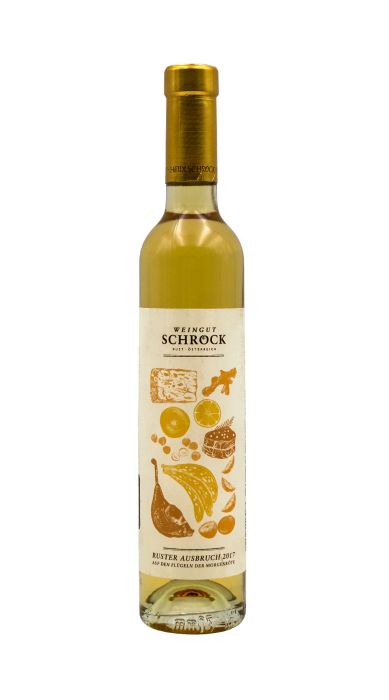Need Help Finding the right wine?
Your personal wine consultant will assist you with buying, managing your collection, investing in wine, entertaining and more.
By continuing, you agree to our privacy policy, consent to cookies, and confirm you are 21 or older.
I have read and agree to the Privacy Policy and Terms of Service.
YOU MUST BE 21 OR OLDER TO CONTINUE
NYC, Long Island and The Hamptons Receive Free Delivery on Orders $300+
Cool Wine Shippers Now Available.
Checkout using your account
Checkout as a new customer
Creating an account has many benefits:

2017 Weingut Heidi Schrock Ruster Ausbruch On the Wings of Dawn
97 RP
| Type of Wine | Dessert |
|---|---|
| Varietal |
Proprietary Blend
: Proprietary Blend is a general term used to indicate that a wine is comprised of multiple grape varietals which are either “proprietary” to the winery or is blended and does not meet the required maximum or minimum percentage of a particular varietal. This also is the case for the grape’s place of origin, especially for region, appellation or vineyard designated wines. There are endless examples of blended wines which are labeled as “Proprietary Blend” and in conjunction with each region’s stipulated wine laws and regulations makes for a vast blanket for wines to fall into. Perhaps the simplest example is California; if a wine is to be labeled as Napa Valley Cabernet Sauvignon, it is required to have at least 75% of the varietal (Cabernet Sauvignon) and 85% of the fruit must be cultivated from the Napa Valley wine district. If the wine does not meet the requirements, it is then labeled as Proprietary Blend. |
| Country |
Austria
: The landlocked country of Austria, in the heart of Europe, is a land of breathtaking beauty; from its rolling hills, steep slopes and valleys to its many terraces and specific regional sites which possess features that belong to the visible charm of the country’s landscape. Hidden beneath the precious soils and rocks of this wondrous landscape, which may not be visible, but of great importance to winemaking is the life-blood of the land because it significantly influences the choice of grape variety and vineyard management. This geological and vinification symbiosis has become an incredible proficiency that Austrian winemakers have honed over a long period, creating wines that truly define the terroir. Of all the major winegrowing regions in Austria, Wachau, Kremstal and Kamptal have certainly proved to be the finest locations for cultivating high quality grapes. These regions reside on the eastern part of the country, where the terroir and climate are perfectly attuned to the varietals cultivated. Lower elevations consist largely of rich, deep soils composed mostly of loess, giving way to heavy, fruit-forward wines. The many hilly and terraced vineyards are composed of free-draining gravel, which allows for the production of age-worthy wines. Due to the country’s location and the presence of the Alps, there is very little Mediterranean influence, thus creating a strongly continental climate. Warming easterly breezes and high sunshine hours provide plenty of ripening opportunities for the grapes. Ripening happens slowly and evenly here, creating a balance between sugar and acidity in the grapes and, in turn, making balanced wines. However, the climate is still tempered by the presence of the Danube and the Neusidelersee Lake to the south, creating a myriad of micro-climates and further developing complex growing conditions. Austria is renowned for its world-class production of Gruner Veltliner, its most important and most widely planted grape variety. It accounts for 32.5 percent of all vineyard space. In the past, the country was known for its sweet and botrytized version of the varietal, but producers have turned to making a more consumer-friendly, crisp, aromatic style. This modern approach has allowed its star varietal to be mentioned alongside some the finest whites on today’s market. Riesling ranks second among all white grapes grown. The finest examples of these two varietals hail from its three main growing regions (Wachau, Kremstal and Kamptal). White varieties truly dominate the country’s production; of the 44,913 hectares under vine, 30,300 are cultivated to white grape varieties, which include Chardonnay, Sauvignon Blanc, Welschriesling and Pinot Blanc (known here by its German name Weissburgunder). Red wine production may be overshadowed, but to be overlooked. Red grape varieties, such as Blaufrankisch, Saint-Laurent, Pinot Noir (Blauburgunder) and its most prized red varietal, Zweigelt, flourish in the large Austrian region of Burgenland, producing wines of incredible intrigue. Zweigelt is the second most widely planted varietal in Austria, accounting for 13.9 percent of all vineyard space and produces richly colored wines with a deep, bright core of spiced cherry and raspberry flavors. The Austrian wine industry has been molded not only by its prized terroir, but also by the talent and determination of its vintners. Producers such as Heidi Shrock and Weingut Prager have risen to world-class status and are commanding global recognition. Producers may be turning to modernized ways of appeasing ever-changing palates, but is also balancing it with traditional methods, retaining such classics as the sweet Ausbruch and Strohwein. Stricter wine laws and regulations have greatly improved the quality of winemaking and in the process, has garnered world-wide attention. Austrian producers are preserving an age old tradition that began over 2000 years ago, yet reforming it into one of the leading wine producing countries in the world. |
| Region | Burgenland |
| Subregion | Neusiedlersee |
| Appellation | Neusiedlersee |
| Producer | Weingut Heidi Schrock |
|---|
Need Help Finding the right wine?
Your personal wine consultant will assist you with buying, managing your collection, investing in wine, entertaining and more.